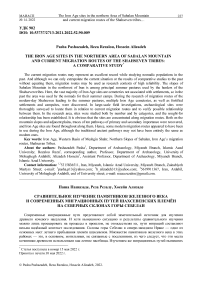The iron age sites in the northern area of Sabalan mountain and current migration routes of the Shahseven tribes: a comparative study
Автор: Pashazadeh Pasha, Rezalou Reza, Alizadeh Hossein
Журнал: Материалы по археологии и истории античного и средневекового Причерноморья @maiask
Рубрика: Археология
Статья в выпуске: 14, 2022 года.
Бесплатный доступ
The current migration routes may represent an excellent record while studying nomadic populations in the past. And although we can only extrapolate the current situation or the results of comparative studies to the past without equating them, migration routes may be used as research contexts of high reliability. The slopes of Sabalan Mountain in the northwest of Iran is among principal summer pastures used by the herders of the Shahseven tribes. Here, the vast majority of Iron Age sites are cemeteries not associated with settlements, so in the past the area was used by the nomads for their summer camps. During the research of migration routes of the modern-day Shahseven leading to the summer pastures, multiple Iron Age cemeteries, as well as fortified settlements and campsites, were discovered. In large-scale field investigations, archaeological sites were thoroughly surveyed to locate them in relation to current migration routes and to verify possible relationship between them. In the research area, sites were studied both by number and by categories, and the sought-for relationship has been established. It is obvious that the sites are concentrated along migration routes. Both on the mountain slopes and adjacent plains, traces of ten pathways of primary and secondary importance were recovered, and Iron Age sites are found throughout along them. Hence, some modern migration routes appeared to have been in use during the Iron Age, although the traditional ancient pathways may not have been entirely the same as modern ones.
Iron age, western basin of meshgin shahr, northern slopes of sabalan, iron age’s migration routes, shahsavan tribes
Короткий адрес: https://sciup.org/14125266
IDR: 14125266 | УДК: 902 | DOI: 10.53737/2713-2021.2022.52.90.009
Текст научной статьи The iron age sites in the northern area of Sabalan mountain and current migration routes of the Shahseven tribes: a comparative study
МАИАСП № 14. 2022
The Iron Age sites in the northern Area of Sabalan Mountain and current migration routes of the Shahseven tribes…
2016), in which the reasons for the continuation of nomadic life in this region and its historical and ecological connections have been studied. The studies related to nomadism and to some extent archeology in different regions of Iran (Fars province, Chaharmahal Bakhtiari and Khorasan) have been conducted by the Iranian and foreign missions (Varjavand 1965; Adams 1974; Zagarell 1975; 1982; Bates, Lees 1977; Pullar 1990; Baharvand 1999; Alizadeh 2008). In Ilam province, the phenomenon of nomadism was first observed by an American delegation led by Frank Hole (1978) in Dehloran. The other researches that have studied the phenomenon of nomadism from an ethnographic perspective include Kramer (1982), Watson (1979), Amanolahi Baharvand (1975), and Mortensen (1993) and Abdi (et al. 2002), that most of it has been done around of the nomads and rural communities in these areas. The other researches in this field in Iran include a study entitled “Ethnoarchaeology of the migration routes in the west of Central Zagros” (Talaei et al. 2014), which relies on the archaeological and anthropological researches from the Neolithic to Islamic eras and the factors that influenced its intensity and weakness, the history of animal domestication, how nomadic communities were formed and its history in the Central Zagros have been studied.
Barth's study (1961) of the Basseri tribes of Fars province has been done mostly to extract the rules of their contemporary socio-political organization from the perspective of “general ecology”. The same is true in the study of the nomadic and sedentary tribes of Lor (Black-Michaud 1974; Feilberg 1952). The Bakhtiaries (Digard 1973) and Qashqaies (Beck 1978) have also been studied from an anthropological rather than an archaeological perspective. Watson’s study (1979) on the nomads and sedentaries of Kermanshah can be considered as the most comprehensive ethnographic study in order to answer archaeological problems. One of the first studies in this field was the Archaeological Surveys of Northern Baluchistan conducted by Marochek. He followed the path of the nomadic tribes of the contemporary region of Baluchistan to identify and study the seasonal settlements of past human groups (Marucheck 1976: 272).
The relatively important studies on the Iron Age have been conducted in the study area. In 1978, Charles Burney studied the Meshgin Shahr plain and reported the existence of 76 sites belonged to different periods (Burney 1979: 156). The survey and excavation of Shahar Yeri site (Hejbari-Noobri 2004; Pourfaraj 2007), the survey of central and satellite castles of Meshgin Shahr (Rezalou and Ayremlou 2014), the excavation in Khoram Abad cemetery (Rezalou 2012), the excavation in Qizil Ghaye cemetery of Ahmad Beyglou village in Meshgin Shahr (Hajizadeh 2014), the survey of the Meshgin Chay river basin (Ayremlou 2018) are the important researches in this region that parts of the field studied by these researches corresponds exactly to the part of the field that has been surveyed and studied in the present article.
In the case of the Shahsavan tribes, some very significant works have been written. Richard Tapper has two very important works about the Shahsavan tribes that have been written from the point of view monograph and ethnography. The first is entitled “Pasture and Politics” (Tapper, 1979) and the second is entitled “Frontier Nomads of Iran” (Tapper 1997). The present book Based on the field and detailed library researches is devoted to the study of the political and social history of one of the great tribal unions of Iran, the Shahsavan of Azerbaijan. Tapper has also published several articles on the Shahsavan tribes (Tapper 1966; 1974; 1988). Another work that has been published in three languages in English, Italian and Persian is the book “Shahsavan” (Sabahi 2018), in which by looking at the historical origin of the Shahavan tribe and examining their settlements, while trying to introduce the handicrafts of these peoples should also pay attention to their customs.
МАИАСП № 14. 2022
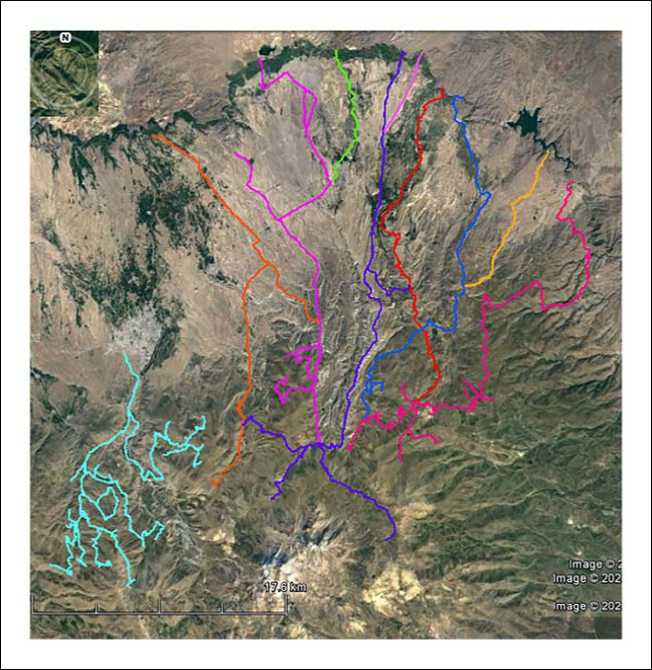
Fig. 1. The study area in the northern part of Sabalan Mountain and the identified migration roads of Shahsavan tribes.
The research area
In the northern part of Sabalan, the area in which the field study was conducted, covers an area of 2250 km2, in which 7 long migration ways and 3 short routes related to the migration of Shahsavan tribes are identified and the Iron Age sites around them were studied and named from west to east with numbers 6 to 15 (Fig. 1). This area leads to Qara Su river from the north, northwest and northeast. In these areas, the Qara Su river has crescentically limited the study area, which starts from the northeast of Arbab kandi village, progresses to the great Sabalan Dam, and after passing through the northern part of villages such as Pirazmian, Lamber, Chapaghan, Qaderlou, Kangarlou, Aqdaraq and Jabdaraq, lead to the area of the northwest and west of Sabalan. Qara Su river passes through the northern part of all these villages and finally joins Ahar Chai river after a few kilometers. The study area is from the west to the western part of Meshgin Shahr city, where urban constructions have started, and the villages located in this part, including Dastgir, Nasirabad, Parikhan, Aqbolagh, Majandeh and Ur are limited. The southern part of the study area leads to the northern slopes of Sabalan. In this section, many migration routes end in high slopes. The westernmost route, No. 6 in this area, after passing the northwestern slopes of Sabalan, enters the summer pastures of East Azerbaijan province, and another branch of it, advancing to the southwestern slopes of Sabalan, enters summer pastures of Ardabil city. In the northeastern part of the high slopes of Sabalan, one of the migration routes, No. 10, passes through the slopes of Sabalan and advances towards the summer pastures of Ardabil and Sarein. In all the ways studied in this area, the point of origin, Qarah Su river and the destination point has been all the summer pastures of Sabalan northern basin within the city of Meshgin Shahr and survey the route of these routes to the end of the border area of this city. In each route, the scope of the field survey extends to the sides by about 2.5 to 3 km; In this way, in fact, all the areas in which these migration routes are located have been thoroughly studied and the place out of sight has not remained in the research area. Although these routes are not currently used and transportation is done by vehicles, the traces of all these migration routes and even their old titles have been preserved.
МАИАСП № 14. 2022
The Iron Age sites in the northern Area of Sabalan Mountain and current migration routes of the Shahseven tribes…
The research findings
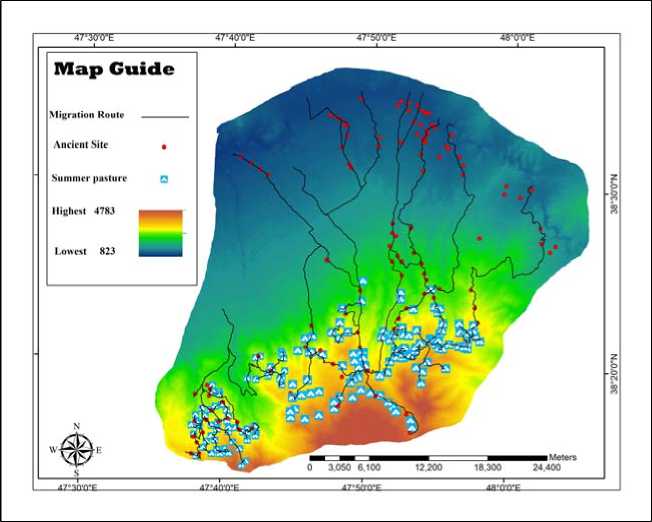
Fig. 2. The sites located along the 10 migration routes of the northern slopes of Sabalan.
In general, 125 Iron Age sites were recorded along these 10 main and secondary migration routes that lead the Shahsavan nomads to the northern slopes of Sabalan (Fig. 2). There are 121 sites, about 96.8% of these sites are of the cemetery type, all of which are unrelated to the settlement sites and specifically belong to the nomadic tribes of the Iron Age. About 50 of these cemeteries are located on the slopes of Sabalan and in the current summer pastures of the Shahsavan tribes. Four of the registered sites are the central forts, satellite and settlement sites, all of which, without exception, were in the plains and along the routes and no traces of this type of sites were seen on the slopes. About 30% of the sites are between 2 and 4 hectares; 25% of them are about 1 to 2 hectares, 15% are between 4 to 6 hectares and about 10% of them are about 0.5 to 1 hectare. The other areas are larger, as shown in chart 1. According to Table 1, 53% of the cemeteries have the stone and soil mound graves; 19% of them have four walls graves, 14% of them have tumulus type and 6% have Kurgan. The other graves account for between 1 and 3 percent.
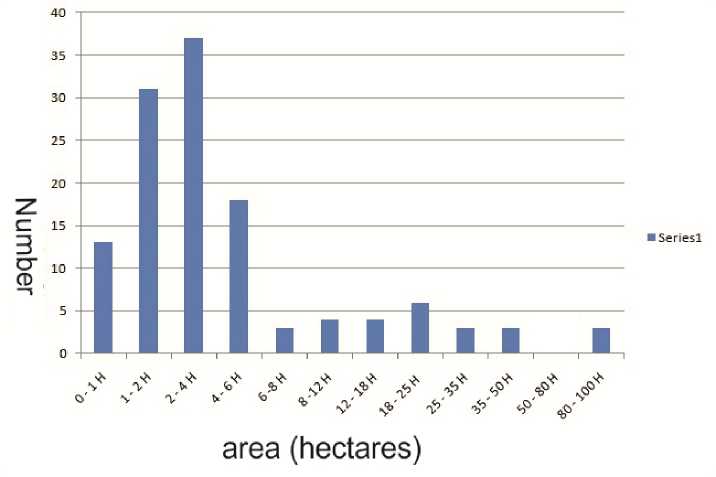
Chart 1. Extent of the sites located on the northern slopes of Sabalan.
МАИАСП № 14. 2022
Table 1 . Number and type of Iron Age sites on the northern slopes of Sabalan.
|
я 2 я OX © |
Castles |
я 8 У у сл |
Number of the cemeteries with different types of graves |
|||||||
|
я |
2 я и |
ъ у 8 |
я я 8 н |
” я я В £ я |
ох S |
S № |
2 X |
ох |
||
|
6 |
0 |
0 |
1 |
19 |
0 |
2 |
2 |
0 |
18 |
0 |
|
7 |
0 |
0 |
0 |
10 |
2 |
1 |
1 |
0 |
9 |
1 |
|
8 |
0 |
0 |
0 |
14 |
1 |
0 |
4 |
2 |
10 |
3 |
|
9 |
0 |
0 |
0 |
3 |
0 |
0 |
0 |
1 |
2 |
1 |
|
10 |
0 |
1 |
0 |
20 |
1 |
1 |
9 |
3 |
15 |
3 |
|
11 |
0 |
0 |
0 |
7 |
1 |
0 |
5 |
1 |
5 |
5 |
|
12 |
0 |
1 |
0 |
17 |
0 |
0 |
5 |
0 |
10 |
4 |
|
13 |
0 |
0 |
0 |
14 |
0 |
0 |
4 |
1 |
9 |
5 |
|
14 |
0 |
0 |
0 |
3 |
0 |
0 |
4 |
1 |
9 |
5 |
|
15 |
1 |
0 |
0 |
14 |
0 |
0 |
2 |
3 |
12 |
0 |
|
Total |
1 |
2 |
1 |
121 |
5 |
4 |
36 |
12 |
99 |
27 |
Migration route No. 6
The total length of the studied path of this migration route is about 75 km. This way extends in a straight line to the south in the northwestern part of Sabalan and the western part of Meshgin Shahr. After passing through the village of Aqbolagh, the route branches into two important ways at the exit of the village. The western branch of this route enters the steep slopes of Sabalan from this point. A little higher, the summer pastures of the Shahsavan tribes begin. This branch moves from route 6 among the pastures and in the eastern part climbs to the high parts of the western slopes of Sabalan and passes through the western side of Sabalan and enters the pastures of Ardabil city in the southwestern part of Sabalan. The eastern branch of road No. 6 in the southern part of Aqbolagh village enters a valley where the Muiel spa is located. This route inside the valley, before reaching the village of Moiel, deviates to the east and enters several summer pastures located in this area. After a few kilometers to the east and southeast, this route joins routes No. 7.
More than 50 summer places in this route were surveyed, all of which were located in the high and verdurous areas of Sabalan slopes. Twenty ancient sites from the Iron Age were identified at the summer pastures of this migration route, all but one of which were cemeteries (Fig. 3). Along the way, in some places at different distances, traces of indicator stones or path signs can be seen. Such rocks are found in most of the paths, some examples of which are presented here (Fig. 4). In the cemeteries, 78% of them had the soil and stone mound tombs, 9% had the four stone walls
1 Some cemeteries have more than one or two types of graves.
МАИАСП № 14. 2022
The Iron Age sites in the northern Area of Sabalan Mountain and current migration routes of the Shahseven tribes… tombs and 9% had the Megalithic tombs (Fig. 5). Nine sites have an extent between 2 to 4 hectares. The extent of three samples is between 4 to 6 hectares and the other four samples are between 1 to 2 hectares. The largest cemetery of this migration route was between 18 and 25 hectares. A site larger than 25 hectares was not identified in the zone. Similar examples to these graves can be found in sites such as Shahr Yeri Cemetery (Hejabari-Nobari 2004: 156—170; Purfaraj 2007: 185—199), Khoram Abad Meshgin Shahr (Rezalou 2012: 90—148; Rezalou, Ayremlou 2014: 75) and observed in the studies of Meshgin Chay river basin (Ayremlou 2018: 205—240).
47°40'0"Е
Route No. 6
Map Guide
Migration Route
Ancient site
Summer pasture I
Rural areas
River
Highest 47*3 Al,i,udc
0 800 1,600
3.200
4.800
6,400
47°40'0"E
Fig. 3. The position of the Iron Age sites in relation to the route and summer tents.
МАИАСП № 14. 2022
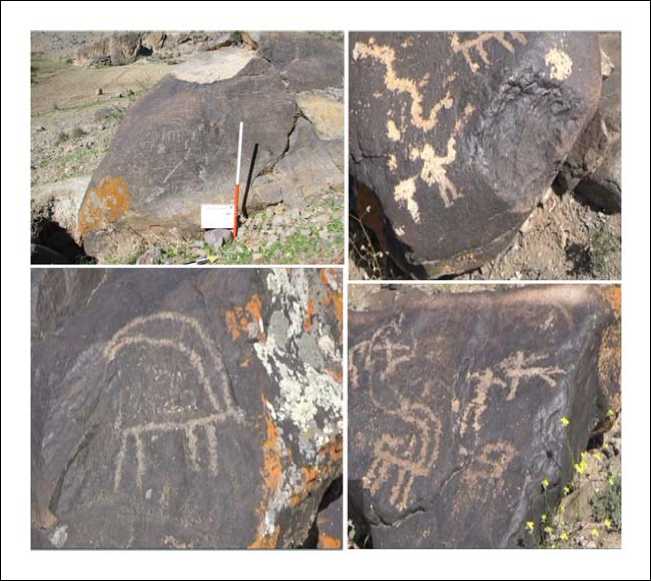
Fig. 4. Examples of the sign stones located next to the migration routes of Shahsavan tribes.
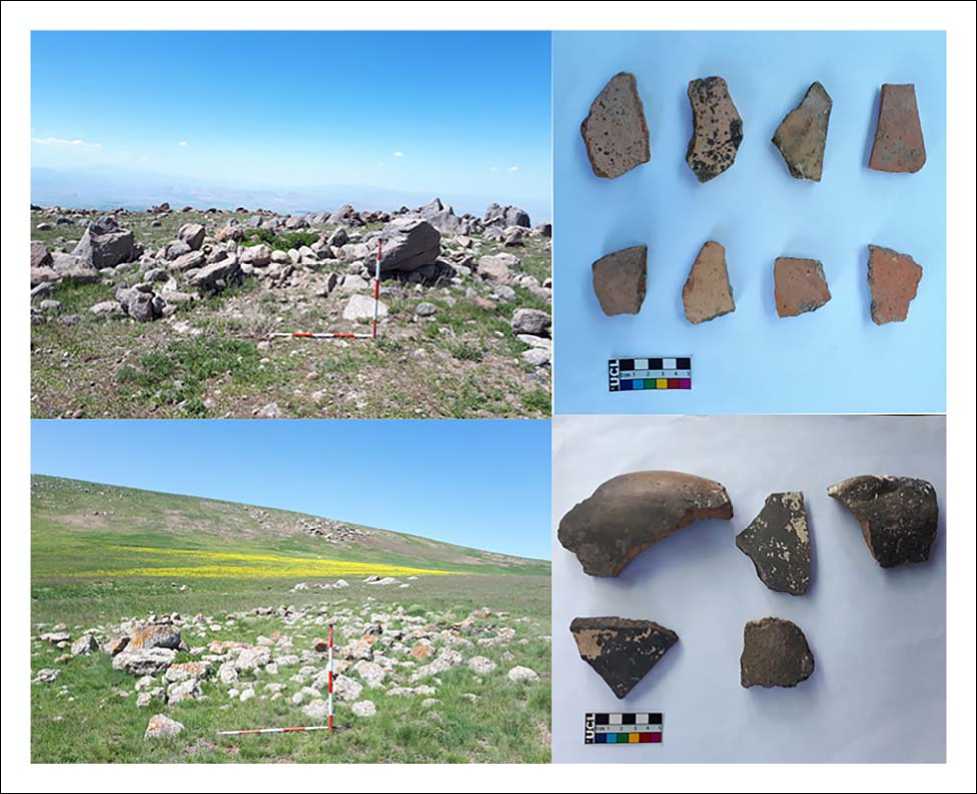
Fig. 5. The examples of burial structures located in the summer tent place.
МАИАСП № 14. 2022
The Iron Age sites in the northern Area of Sabalan Mountain and current migration routes of the Shahseven tribes…
Migration route No.7
The total length of the path along this route is about 35 km. The migration route No. 7 starts from the bed of Qara Su River and from where the village of Aqdaraq is located and extends to the south. After crossing the east of Alni village, it divides into two branches. Its eastern branch joins migration route No. 8 for a short distance as a connector route, and its western branch advances
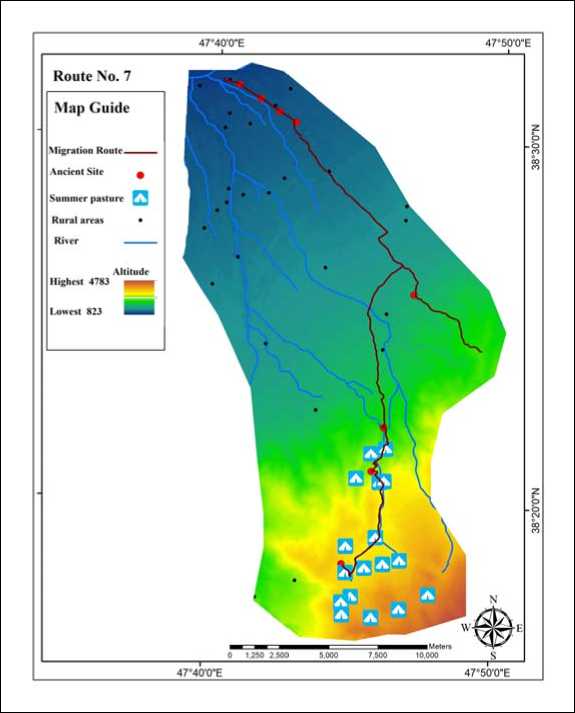
Fig. 6. The position of Iron Age sites in relation to the migration route and location of summer tent.
south in a straight line after passing the western part of Sarbanlar village. After a short path, this route enters the northern slopes of Sabalan and the summer pastures located in this area.
More than twenty summer pastures were located within the confines of this migration rute, which were surveyed. Ten ancient Iron Age sites have been identified along this route, all of which are cemeteries (Fig. 6). Four samples of these sites from the starting point to the slopes and other sites were located in the summer pastures and on the ramp hillsides of Sabalan. The end of this route in the western part is connected to migration route No. 6.65% of the cemeteries have the stony and soil mound tombs, 14% of pit graves, and 7% of four stone walls, Megalithic, and tumulus tombs each. There are three sites with an extent of about 2 to 4 hectares, two sites with an extent of about 1 hectare, two sites with an extent of about 1 to 2 hectares and two sites with an extent of about 4 to 6 hectares.
The largest site of this migration route is between 8 and 12 hectares. Similar samples in terms of pottery findings and tomb structure can be found in ancient sites such as Shahar Yeri (Ebtehaj 2007: 11 — 189; Purfaraj 2007: 125 — 135), Ghezil Qayeh Cemetery (Hajizadeh 2014: 148 — 178); Khoram Abad Meshgin Shahr (Rezalou 2012: 128 — 145), in some cemeteries of Ardabil province (Hesari and Aliyari 2012: 130 — 113) and in some cemeteries in northern Iran (Khalatbari 2004: 120 — 180) can be observed.
Migration route No. 8
The total length of the path studied on the migration route is about 44 km. This way starts from the bed of Qara Su river, from where Jalayer village is located, passes through this village and extends to the northern slopes of Sabalan. After a few kilometers, this route first passes through the western part of Lahroud city and then through the eastern part of Jahad Abad village and enters the steep slopes of Sabalan. The first summer pasture on this route starts from these areas. Along this way, the path divide into several short western branches, the ends of which are not connected to any
МАИАСП № 14. 2022
other road and end at the same downstream slopes. A branch of this migration route that moves directly to the northern slopes eventually connects to migration route No. 10 near a very important summer pasture called Hushang Meydani.
About 20 to 25 summer places of Shahsavan nomads in the area of this way were studied and along the route and in the summer places, 14 ancient sites from the Iron Age were identified
(Fig. 7). From all these sites, five of them were at the end of the route and at the summer pastures and the rest were at the beginning of the route and at the Meshgin Shahr plain. All fourteen sites are cemeteries. Among these sites, ten sites have tombs of soil and stony mound, four sites have four stone walls tombs, three sites have tumulus tombs, two sites have the Kurgan tombs and a site has the pit burials. Eight sites have an extent in about 1 to 2 hectares, three sites have an extent in about 2 to 4 hectares, two sites have an extent in about 4 to 6 hectares and a site has an extent in about 1 hectare. The sites along this migration route were small in the extent.
Migration route No. 9
This route is a short path that starts from the bed of Qara Su river and from the eastern part of Kangerlou village and extends to the south. This road enters Lahroud city after a path of about 11 km and in the southwestern
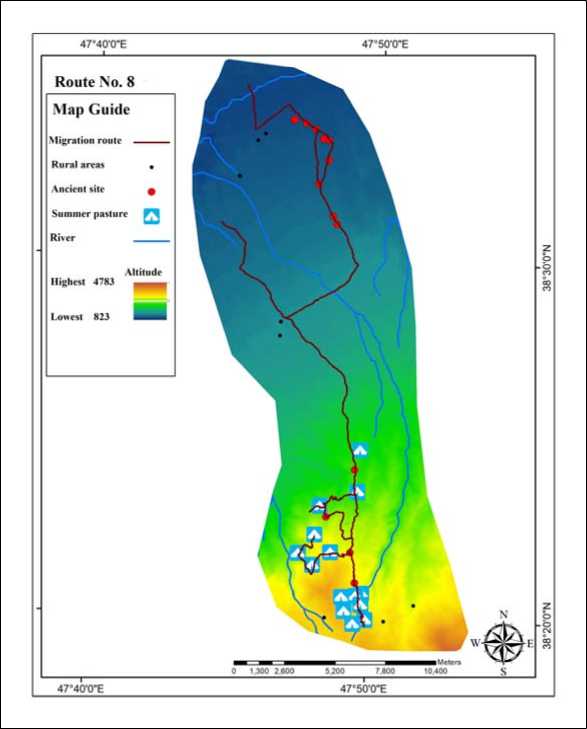
Fig. 7. The position of Iron Age sites in relation to the migration route and location of summer tent.
part and the exit of this city towards the slopes of Sabalan, it is connected to migration route No. 8. Three Iron Age sites were identified along the route, all of which are cemeteries. Two examples of them are graves of stony and soil mound type, one is the grave of Kurgan and one is the tomb of tumulus. One of them has an extent in about 1 to 2 hectares, a site is 2 to 4 hectares and the other is 4 to 6 hectares.
Migration route No. 10
This road is one of the most important migration route in Meshgin Shahr plain and the northern slopes of Sabalan, which starts from the bed of Qara Su river and from where the village of Qaderlou is located, and after passing through the village of Chapaghan and from the side of the Iron Age castle of this village, it extends to the south. After a few kilometers, this route first enters Fakhr Abad and then enters the village of Onar. After this village, this migration route gradually entered the steep slopes of Sabalan and after passing the western part of Bineller village, a main route went to the south and a connector way from this migration route is branched to the east and
МАИАСП № 14. 2022
The Iron Age sites in the northern Area of Sabalan Mountain and current migration routes of the Shahseven tribes… connects to migration route No. 12. In the southern parts of this route and near the famous summer pasture of Hushang Meydani and before reaching this place, this migration route becomes three subroutes. Its eastern branch goes to the eastern slopes of Sabalan and reaches the famous summer place of Qizilbireh, and from there and from the highest part of this basin flows to the east of Sabalan and goes to the northern and western summer pastures of Sardabeh village, that it is one of the summer pasture of Ardabil city. The western branch of migration route No. 10 enters the summer place of
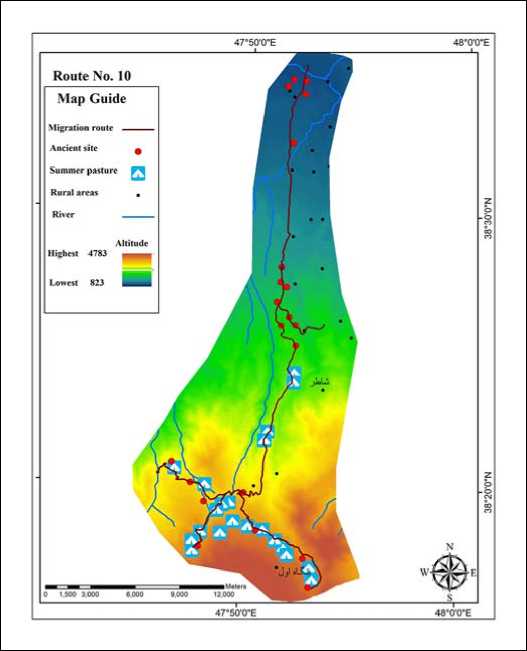
Fig. 8. The position of Iron Age sites in relation to the migration route and location of summer tent.
Hushang Meydani and moves inside the countless summer pastures of this area. The other branch of this route advances west to route No. 7 and eventually connects to it (Fig. 8).
The total length of the path studied along this migration route is about 65 km, during which 21 ancient sites from the Iron Age were identified, that the exception of one example of a central castle from the Iron Age, all are cemeteries. Among these cemeteries, 46% have stony and soil mound tombs, 27% have four stone walls tombs, 9% have Kurgan tombs, 9% have tumulus tombs, 3% have pit graves and 3% have megalithic tombs (Fig. 9). In terms of extent, five sites have an extent of about 1 to 2 hectares, five sites have an extent of about 2 to 4 hectares, three sites have an extent of about 18 to 25 hectares and two sites have an extent of about 25 to 35 hectares. Several large sites were identified along the migration route, the largest of which was 100 hectares. The samples similar to the types of graves can be found in sites such as
Zardkhaneh of Ahar city (Niknami and
Kazempour 2012: 120 — 55), Gilavan Khalkhal (Rezalou 2008a: 156 — 124), Qaleh Khosrow Cemetery (Rezalou 2008b: 124 — 85) and the castle of Boyni Yoghun (Purfaraj 2008: 45 — 89) observed.
Migration route No. 11
Migration route No. 11 is a short path that starts from the bed of Qara Su river and where the village of Qaderloo is located and continues to the south. After passing through the village of Qaderloo, this route passes from the west and at a distance of 1 km from the village of Lamber, and after a distance of 7 km at the entrance of Fakhr Abad, it connects to migration route No. 10 and then continues to the slopes of Sabalan. Seven archeological sites were identified along this route, most of which are located on the eastern side (Fig. 10). All of them are cemeteries; five sites have tombs of stony and soil mound types, five sites have four stone walls tombs, five sites have tumulus type graves, one site has pit graves and one site has Kurgan tombs. As it is known, most of the sites have more than one or two types of graves, which is interesting in its kind. In terms of extent, one of the sites has an extent of about 1 hectare, two sites with an extent of about 1 to 2 hectares, two sites with an extent of about 2 to 4 hectares, one site with an extent of about 18 to 25 hectares and one of them has an extent of about 80 to 100 hectares.
МАИАСП № 14. 2022
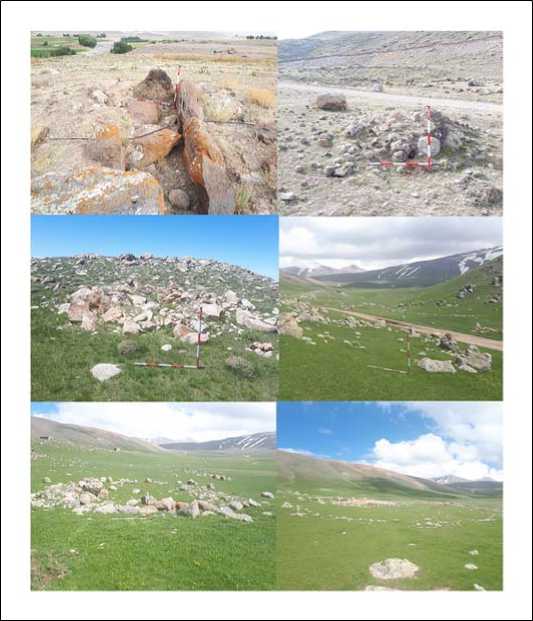
Fig. 9. The examples of burial structures located in the summer tent place.
Fig. 10. The migration route 11 and the sites along the route.
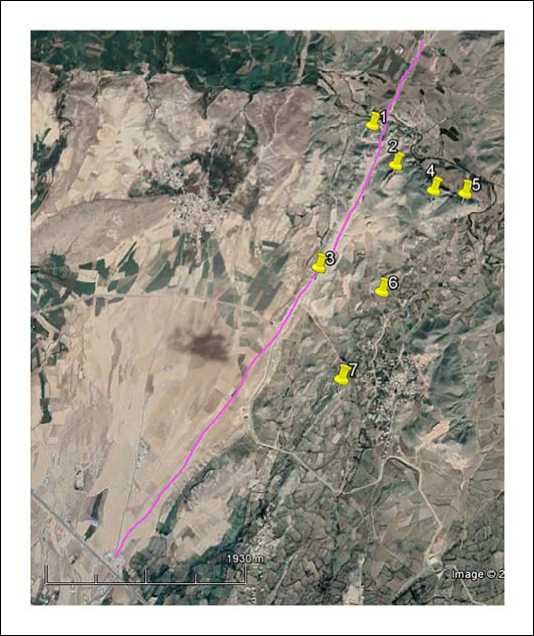
МАИАСП № 14. 2022
The Iron Age sites in the northern Area of Sabalan Mountain and current migration routes of the Shahseven tribes…
Migration route No. 12
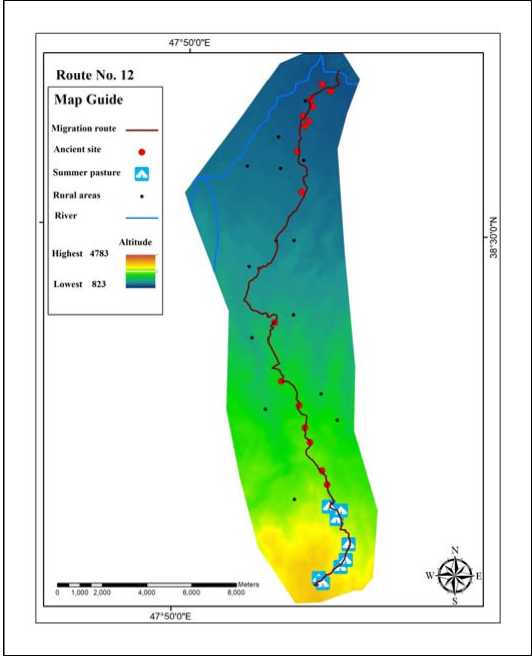
Fig. 11. The position of Iron Age sites in relation to the migration route and location of summer tent.
The total length of the path along this migration route is about 35 km. This way starts from the bed of Qara Su river and from a place called Ghosha Darmai and after a short distance in the eastern direction in the bed of Qara Su river, it changes its direction to the south and the slopes of Sabalan. After two kilometers, this way enters the village of Lamber, and after passing through the village, moves towards the village of Arjagh, and after passing through this village, after a few kilometers, from inside the village of Ali Abd, and the east side of Onar village and moves towards Qozlu village. This migration route passes from the western side of this village and enters the steep and verdurous slopes of Sabalan. This north-south route eventually connects to migration route No. 15, which runs east-west. Eighteen archeological sites from the Iron Age were identified along the route and in the summer pastures located within the area of this migration route, of which, except for one example of the central castle, all other sites are cemeteries (Fig. 11); Of them, seven sites have an extent of about 2 to 4 hectares, three sites 1 to 2 hectares, three sites 4 to 6 hectares, two sites 6 to 8 hectares, one site 8 to 12 hectares, one site 12 to 18 and one sites 35 to 50 hectares. Among the cemeteries, there are ten sites have the stony and soil mound tombs, five cemeteries have the four stone walls tombs and four sites have tumulus type tombs (Fig. 12).
Migration route No. 13
This route starts from Qara Su river and from a place called Kopak Boghan and after a short path in east-west, it changes its direction to south and Pirazmiyan village. This road enters the village of Pirazmiyan after passing through the western side of Shahar Yeri cemetery and advances to the south from its western side. The migration route, after passing through the western side of the lower Naqdi village and then from inside the upper Naqdi village, to the villages of Yasti Bulagh, Mis Darasi and then the verdurous and high slopes of Sabalan, and finally to the end of migration route No. 15 is connected. The total length of the path along this route is about 40 km.
In total, fourteen ancient sites from the Iron Age have been identified in this route, which seven sites of them were at the beginning of the route and the other sites at the end of the route and in the summer pastures (Fig. 13). All of these sites are the cemetery, that in the nine sites, there are the stony and soil mound graves, in the five samples the tumulus graves, in the four sites the four stone walls tombs and in the one sample there are Kurgan graves. In terms of extent, there are five sites, including small areas of 1 hectare; three sites of about 1 to 2 hectares, two sites of about 2 to 4 hectares, one site of about 4 to 6 hectares, one site of about 12 to 18 hectares, one case of about 25 to 35 hectares and a site also has an extent of about 80 to 100 hectares.
МАИАСП № 14. 2022
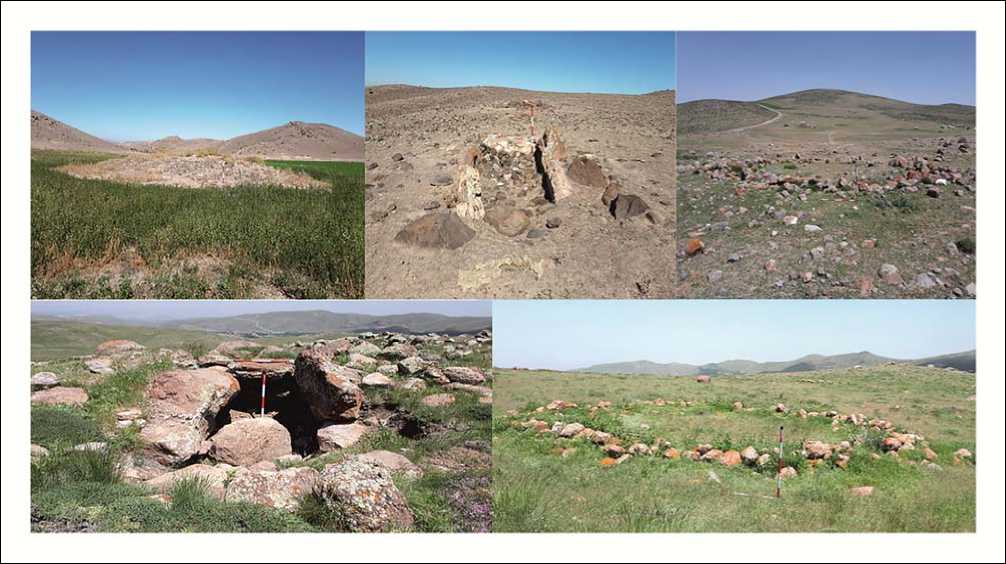
Fig. 12. The examples of burial structures located in the summer tent place.
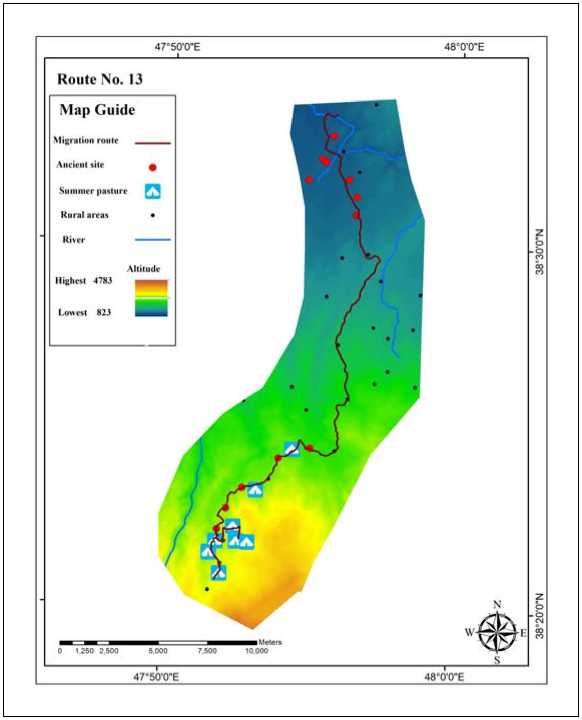
Fig. 13. The position of Iron Age sites in relation to the migration route and location of summer tent.
МАИАСП № 14. 2022
The Iron Age sites in the northern Area of Sabalan Mountain and current migration routes of the Shahseven tribes…
Migration route No. 14
This way is a short path that starts from the bed of Qara Su river and from the east side of Sabalan dam and progresses to the south. After crossing the eastern side of Qilpinlu village and inside the village of Dash Bulagh and Yasti Bulagh, this migration route connects to route No. 13, in the entrance of Mes Darasi village and moves towards the slopes of Sabalan. Three sites were identified along this short route, which all of them were cemeteries. Two sites have an extent of about 2 to 4 and one site has an extent of about 4 to 6 hectares. Two sites have stony and soil mound tombs, one site has tumulus tombs and one site has the four stone walls tombs. The total length of the migration route is about 13 km.
Migration route No. 15
This migration road, which is known as Dojagh route, starts from the bed of Qara Su river and from the northwest of Arbabkandi village and extends to the south. This long route, after a few
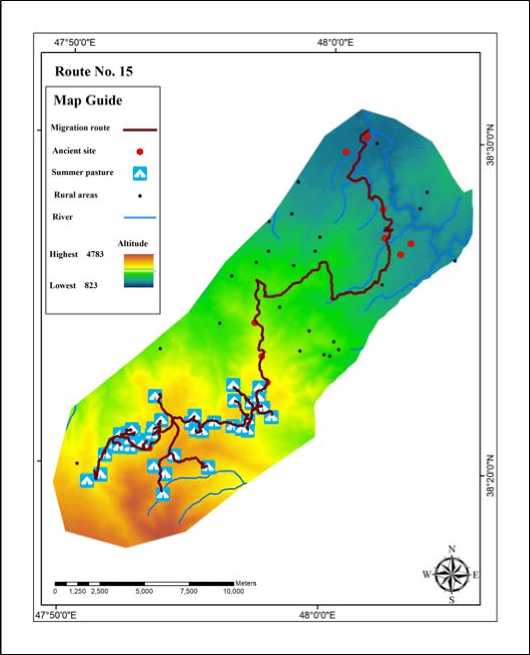
Fig. 14. The position of Iron Age sites in relation to the migration route and location of summer tent.
kilometers inside the deep valleys, moves towards the steep slopes of Sabalan. This route moves approximately along the border of Ardabil and Meshgin Shahr cities and changes direction to the west at the entrance of Gendishmin village and enters the northeastern slopes of Sabalan. In Gendishmin village, a side way of this road branches to the south and summer pastures of Ardabil city and Sardabeh city.
The total length of the path along this migration route is about 60 km. This route eventually joins its western migration routes at the Qotursuie Spa. The fifteen archeological sites from the Iron Age along this route and the summer pastures of the Sabalan slopes were identified, except for one site of satellite castle; all of them were cemeteries (Fig. 14). There are twelve cemeteries with tombs of stony and soil mound, three sites with Kurgan tombs and two cemeteries with the four stone walls tombs. In terms of extent, two sites with an extent of about 1 hectare, three sites with an extent of about 1 to 2 hectares, three sites with an extent of about 2 to 4 hectares, three sites with an extent of about 4 to 6 hectares, two sites with an extent of about 12 to 18 hectares, a site with an extent of about 18 to 25 hectares and finally a site with an extent of about 35 to 50 hectares.
МАИАСП № 14. 2022
Conclusion
The slopes of Sabalan are one of the most prone areas in the eastern part of northwestern Iran, which has historically welcomed communities that have sought large pastures for their livestock. Based on the results of a field survey of the slopes of Sabalan and the identification of many cemeteries that were located in the current summer pastures, it seems that this very large area in the Iron Age has accommodated several nomadic tribes. The absence of any settlement sites or castles in any part of this area from the Iron Age indicates that this large part, due to its special climatic conditions and characteristics, is only the place of seasonal summer place of nomadic tribes and the conditions of that period did not allow for the seasonal or permanent settlement to the communities, unlike today, which in some altitudes, despite the very bad weather conditions from late autumn to early spring, several settlements have been established. The results of the field study showed that in terms of the size and quality of burial structures, the best sites are located in the present-day summer pastures of the Shahsavan tribes. This suggests that the places that have been chosen as summer resorts today are the best places for the temporary accommodation, and most likely, these places were also used in the Iron Age. Many Iron Age cemeteries are located right on the site of the current tents of the Shahsavan tribes, between the summer pastures.
Another noteworthy point is the relative conformity of today's roads with the distribution of Iron Age sites; the Iron Age sites are located in such a way that they are located in a longitudinal ridge relative to the migration routes of the Shahsavan tribes. It seems that the migration routes and ethnic and tribal movements that took place in the Iron Age and the tribes used them to access the summer pastures on the slopes of Sabalan have been crossed from the current or nearby migration routes; the paths that have certainly been formed in relation to natural factors and complications and have maintained their special status to this day.
Undoubtedly, the establishment of a migration route as an easy access route for migration has taken place over several centuries and millennia; the routes that were constantly traveled and based on experience, their quality has been tested for a long time and the most suitable ones have been selected in terms of life and financial security. The migration routes that were studied in the present article and field survey are no exception. By looking at the general map of all the routes and the distribution of the Iron Age sites, the location of these sites along the path of these migration routes is quite obvious. As the paths progress to the sides, the number of the sites decreases. This way of distributing the sites shows that the sites are in a longitudinal line, and this longitudinal line is the same as the migration route of the current and most likely ancient roads.
The study of the migration roads in this area contains other points. All routes are avoided as much as possible in the valleys and along the precipices and steep slopes. Only in cases where livestock had to enter the riverbed to rest and water them, longitudinal movement in the path and inside the riverbed has been avoided and entry into the riverbed only vertically and to cross they are done. In all routes, until reaching the low and steep slopes of Sabalan, there has been continuous movement on the plain and areas that have a complete view of the surroundings.
The survey of the location of current summer pastures of Shahsavan tribes in the highest parts of the Sabalan slopes has shown the use of all the capacity of them in the Iron Age. Due to the existence of Iron Age cemeteries in these places, it seems that where there was a flat place to set up tents, or the possibility of climbing to higher areas and the possibility of temporary accommodation there, the nomadic communities used it.
In addition to the Iron Age sites on the slopes and in the summer pastures, along the tribal route and on the flat surface of the Meshgin Shahr plain, there are many sites, most of which are cemeteries without connection to the settlement sites that undoubtedly indicates the temporary
МАИАСП № 14. 2022
The Iron Age sites in the northern Area of Sabalan Mountain and current migration routes of the Shahseven tribes… settlement of nomadic tribes in these places as well. It seems that in the Iron Age, these places were settled and used in the summer seasons of the year compared to other areas that had a higher position and their snow melted later; and after sufficient exploitation, it was done from pastures and cattle were in distress the temporary accommodation and tents were changed and nomadic tribes climbed to better and higher places and set up their tents in new places.
Список литературы The iron age sites in the northern area of Sabalan mountain and current migration routes of the Shahseven tribes: a comparative study
- Abdi et al. 2002: Abdi, K., Nokandeh, G., Azadi, A., Biglari, F., Heydari, S., Farmani, D., Rezaii, A., Mashkour, M. 2002. Tuwah Khoshkeh: A Middle Tuwah Khoshkeh: A Middle Chalcolithic Mobile Pastoralist Camp-Site in the Islamabad Plain, West Central Zagros Mountains, Iran. Journal of the British Institute of Persian Studies 40, 43—74.
- Adams, R.Mc. 1974. The Mesopotamian Social Landscape: A Viewfrom the Frontier. Reconstruction Complex Societies Supplementto the Bulletin of Amrican Schools of Oriental Research 20, 1—11.
- Alizadeh, A. 2008. Formation of the Nomadic Rule of Elamite. Chaharmahal va Bakhtiari: Cultural Heritage Publishing House (in Persian).
- Amanolahi-Baharvand, S. 1975. The Baharvand, former pastoralists of Iran. PhD Thesis. Houston: Rice University.
- Amanollahi Baharvand, S. 1999. Nomadism in Iran, Research on tribes and nomads. Tehran: Agah press (in Persian).
- Askarpour, V., Tirandaz, A., Ajourlou, B. 2016. An Introduction to the Archaeological Ethnography of the Central Qara Dagh Nomads. Anthropological Research of Iran 6 (1), 118—101 (in Persian).
- Ayremlou, Y. 2015. Spatial-Statistical Analysis of Settlement Patterns of Prehistoric sites of Meshgin Chay river Basin: Based on the Archaeological Survey. PhD Thesis in Archeology. Ardabil: Mohaghegh Ardabili University.
- Barth, F. 1961. Nomads of south Persia. Universitetets EtnografiskeMuseum Bulletin 8.
- Bates, D.G., Lees, S.H. 1977. The Role of Exchange in Productive Speccialization. American Anthropologist 79, 824—841.
- Beck, L. 1978. Women among Qashqai nomadic pastoralists in Iran. In: Beck, L., Keddie, N. (eds). Women in the Muslim World. Cambridge MA; London: Harvard University Press.
- Black-Michaud, J. 1974, An ethnographic and ecological survey of Luristan, Western Persia: modernization in a nomadic pastoral society. Middle Eastern Studies10 (2), 210—228.
- Burney, C.A. 1979. Meshkin Shar Survey. Iran 8 (2), 1—71.
- Digard, J.P. 1973. Histoire et anthropologie des sociétés nomades: le cas d'une tribu d'Iran. Annales. Histoire, Sciences Sociales 28 (6), 121—140.
- Feilberg, C.G. 1952. Les Papis. Tribu persane de nomades montagnards du sud-ouest de l'Iran.
- Nationalmuseets Skrifter. Etnografisk Rœkke 4. Hajizadeh, K. 2014. The final report of the first season of excavation in Ghizil ghayeh Cemetery of Meshgin Shahr. Tehran: Archaeological Research Institute of the Cultural Heritage; Tourism and Handicrafts Organization (in Persian).
- Hejbari-Noobri, A. 2004. Preliminary report of the third season of excavation of Shahar Yeri site. Tehran: Archaeological Research Institute of Cultural Heritage, Tourism and Handicrafts (in Persian).
- Hole, F. 1978. Pastoral Nomadism in Western Iran. In: Gould, R.A. (ed.). Explorations in Ethno Archaeology. Albuquerque: University of New Mexico Press, 127—167.
- Kramer, C. 1982. Village ethnoarchaeology; rural Iran in archaeological perspective. Cambridge MA: Academic Press.
- Marucheck, J.T. 1976. A Survey of Seasonal Occupation Sites in Northern Baluchistan. In: Bagherzadeh, F. (ed). Proceedings of the Forth Annual Symposium on Archaeological Research in Iran. Tehran: Iranian Center For Archaeological Research, 272—283.
- Mortensen, I.D. 1993. Nomads of Luristan, History, Material Culture, and Pastoralism in Western Iran.
- London: Thames and Hudson. Pullar, J. 1990. Tepe Abdul Hosein a Neolithic Site in Western Iran. Oxford: BAR (BAR International Series 563).
- Purfaraj, A. 2007. Review of the Iron Age of Northwestern Iran: A Case Study of Shahar Yeri site and Satellite Castles. PhD Thesis in Archeology. Tehran: Tarbiat Modares University.
- Rezalou, R. 2012. The final report of the first excavation season of Khoram Abad Meshgin Shahr cemetery. Tehran: Archaeological Research Institute of the Cultural Heritage; Tourism and Handicrafts Organization (in Persian).
- Rezalou, R., Ayremlou, Y. 2014. The Late Bronze Age and Iron Age Culture of Ardabil Plain: A Case Study of Qaleh Khosrow Castle and Satellite Castles. Iranian Archaeological Research 4 (6), 84—65 (in Persian).
- Sabahi, T. 2019. Shahsavan (Review of the handicrafts of Shahsavan nomads). Tehran: [s.n.] (in Persian).
- Talaei, H., Noorollahi, A., Firoozmandi, Sh.B. 2014. Archeology of nomadism and the west Zagros Highlands. Historical Sociology 6 (2), 163—194 (in Persian).
- Tapper, R. 1966. Black Sheep, White Sheep and Red-Heads: A Historical Sketch of the Shahsavan of Azarbaijan. Iran 25, 61—84.
- Tapper, R. 1974. Shahsevan in afavid Persia. Bulletin of the School of Oriental and African Studies 37 (02), 321—354.
- Tapper, R. 1979. Pasture and politics: Economics, conflict, and ritual among Shahsevan nomads of Northwestern Iran. Cambridge MA: Academic Press (Studies in anthropology).
- Tapper, R. 1988. History and identity among the Shahsevan. Iranian Studies 21 (3-4), 84—108.
- Tapper, R. 1997. Frontier Nomads of Iran: A Political and Social History of the Shahsevan. Cambridge: Cambridge University Press.
- Varjavand, P. 1966. Method of study and general knowledge of tribes and nomads. Tehran: Institute of Social Studies and Research; University of Tehran (in Persian).
- Watson, P. J. 1979. Archaeological ethnography in western Iran. Tucson: University of Arizona Press.
- Zagarell, A. 1975. Nomad and setteled in the Bakhtiari mountains. Sociologus 25, 127—138.
- Zagarell, A. 1982. The Prehistory of the Northeast Bahtiyari Mountains, Iran: The Rise of a Highland Way of Life. Wiesbaden: Dr Ludwig Reichert (Tubinger Atlas Des Vorderen Orients).

